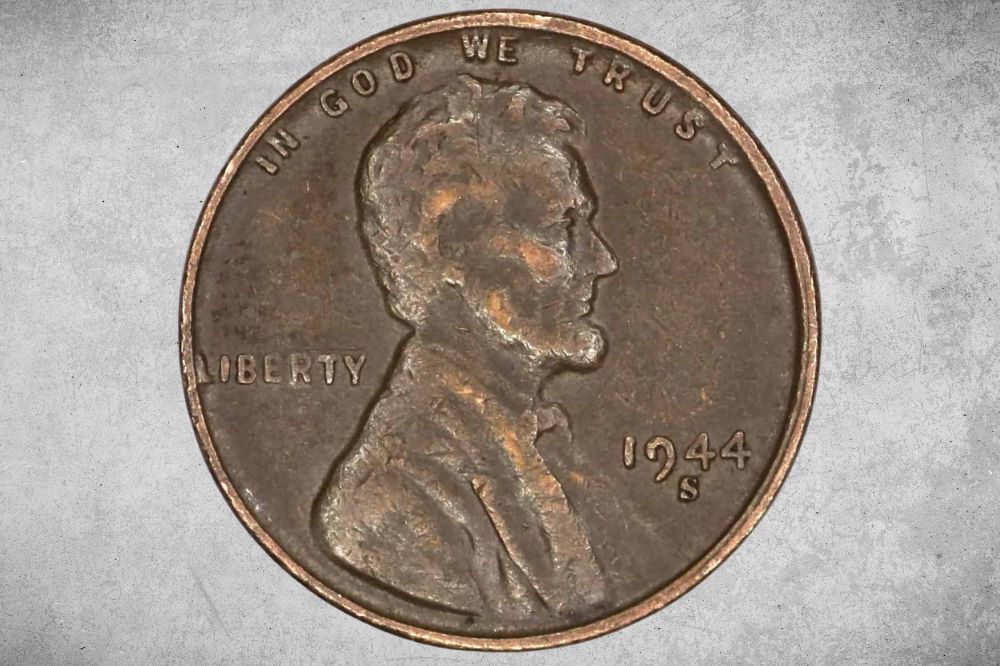Have you ever found a 1944 steel penny? Are you thinking of selling it and wondering how much you can get for it? If so, we can help you out.
In today’s article, we are doing a deep dive into the 1944 steel penny value, varieties, errors, features, and history.
1944 Steel Penny Details
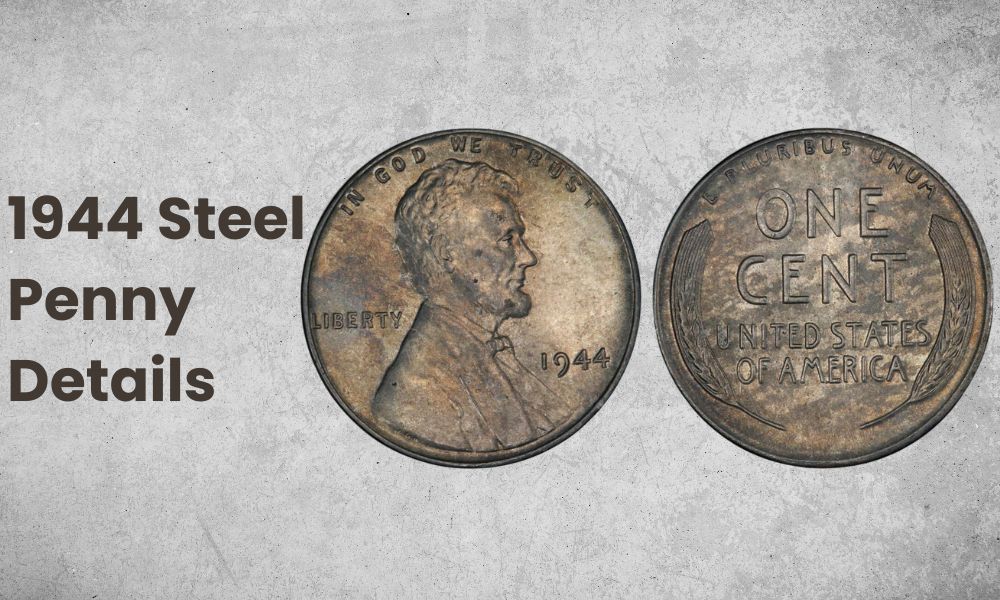
- Category: Lincoln Cents (Wheat Reverse)
- Total Mintage: 38
- Minting place: Philadelphia, Denver, and San Francisco
- Weight: 2.7 g
- Diameter: 19 mm
- Edge: Plain
- Face value: $0.01 (1 cent)
- Composition: Zinc-coated steel
- Engraver: Victor D. Brenner
1944 Steel Penny’s Obverse Design
This coin’s obverse bears Abraham Lincoln’s image. The featured image is of his bust and it’s facing right. It is located at the center of the coin and has a legend that says “IN GOD WE TRUST” running above its head.
On the left, behind Lincoln’s neck, there is a “LIBERTY” and on the right of him, there’s a date engraving. Below this date, there is usually a mint mark. The mark is “S” for coins minted in San Francisco and “D” for those from Denver.
This obverse also has the initials “VDB” where Lincoln’s shoulder meets the coin’s bottom rim.
1944 Steel Penny’s Reverse Design
At the center of this penny’s reverse, there are the words, “ONE CENT” and “UNITED STATES OF AMERICA”. The first words are in a bigger font and are located above the second ones.
Around these words, along the right and left rims of these words are wheat stalks; one on each side. Also, there’s a legend along the coin’s top rim that says, “E PLURIBUS UNUM”.
Other Features of the 1944 Steel Penny
These pennies are made of zinc-coated steel. This was the steel that was leftover from the 1943 mintage. It was made by electrolyzing a carbon steel core to get some zinc on it. This results in a coin with a zinc layer thickness of 0.013 mm.
Besides that, this coin has a round shape with a diameter of 19 mm and a plain smooth edge. It also has a mass of 2.7 grams.
Also Read: Top 20 Most Valuable Old Pennies Worth Money (Penny Collection)
Value Chart
1944 Steel Penny Value Chart |
|||
| Type | EF40 | AU50 | MS60 |
| 1944 No Mint Mark Steel Penny (P) | $28,893 | $34,803 | $58,491 |
| 1944 “D” Steel Penny | $34,803 | $46,688 | $62,001 |
| 1944 “S” Steel Penny | $409,304 | $564,655 | $759,524 |
1944 Steel Penny Value and Varieties Guide
1944 No Mint Mark Steel Penny (P) Value
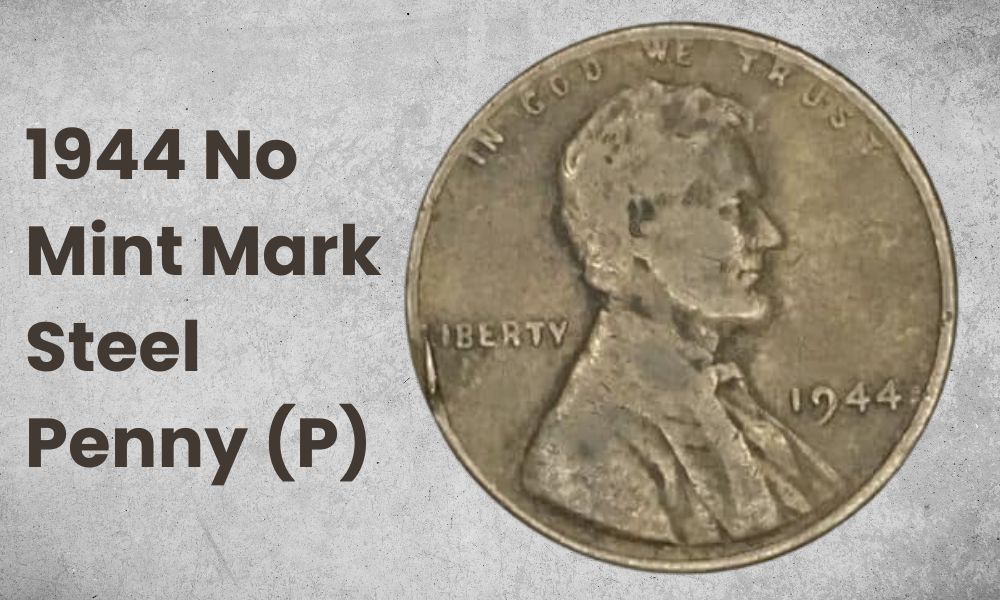
- Type: Lincoln Cents (Wheat Reverse)
- Mint Mark: None
- Minting place: Philadelphia
- Year: 1944
- Edge: Plain
- Mintage: 30
- Designer: Victor D. Brenner
- Face value: $0.01
- Current value: $5,000 to $185,000
- Composition: Zinc-plated steel
- Mass: 2.7 g
- Diameter: 19 mm
It’s estimated that the Philadelphia mint only produced thirty 1944 steel pennies. All of them are regular-strike coins and don’t have a mint mark. Since the mint had decided to stop using steel for pennies in 1943, these were created by mistake.
There are currently two theories about how this accident happened. The first one was that some steel blanks were leftover from 1943 and accidentally ended up being minted with the normal 1944 bronze cents.
The second one was that steel blanks that were meant for a foreign currency found their way into the bronze cent production stream. Either way, these pennies are rare and sell for a premium; one can go for $5,000 to $185,000. An MS64 usually goes for over $100,000.
1944 “D” Steel Penny Value
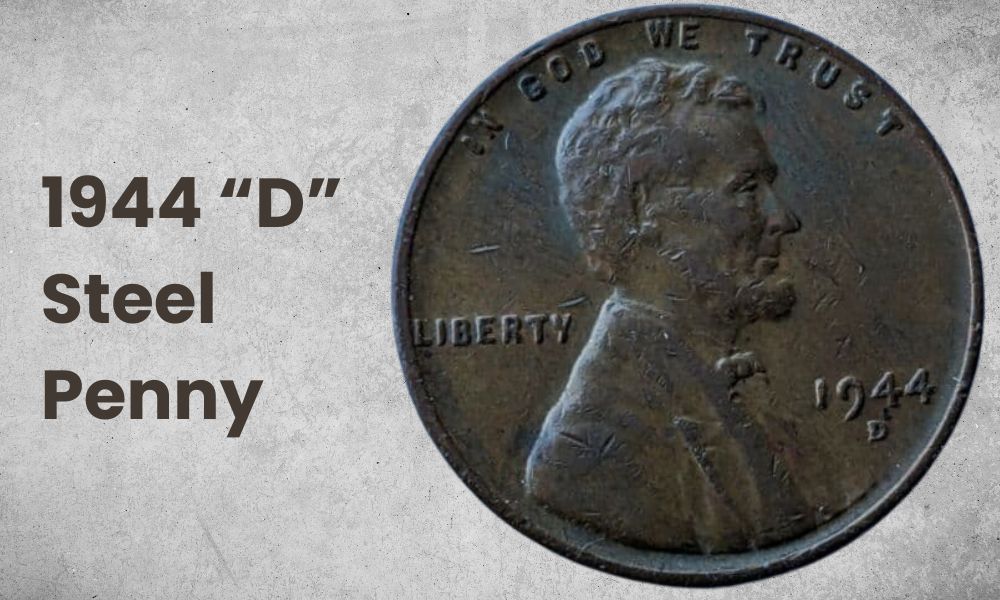
- Type: Lincoln Cents (Wheat Reverse)
- Mint Mark: D
- Minting place: Denver
- Year: 1944
- Edge: Plain
- Mintage: 7
- Designer: Victor D. Brenner
- Face value: $0.01
- Current value: $30,000 to $115,000
- Composition: Zinc-plated steel
- Mass: 2.7 g
- Diameter: 19 mm
Only seven 1944 D steel cents have been found so far. These were minted at the Denver facility accidentally. All of them were regular-strike coins and had a “D” mint mark.
It’s widely agreed that the only way these coins could have been produced was by leftover blanks from 1943 getting into the 1944 bronze cent production stream.
This is because, unlike the Philadelphia mint, the Denver facility was not minting foreign currency at this time. Since these pennies are few, they sell for a premium price, even higher than the price of their Philadelphia counterparts.
AU53 to MS62 samples usually fetch $30,000 to $100,000 per piece. An MS63 can go for as high as $115,000.
1944 “S” Steel Penny Value
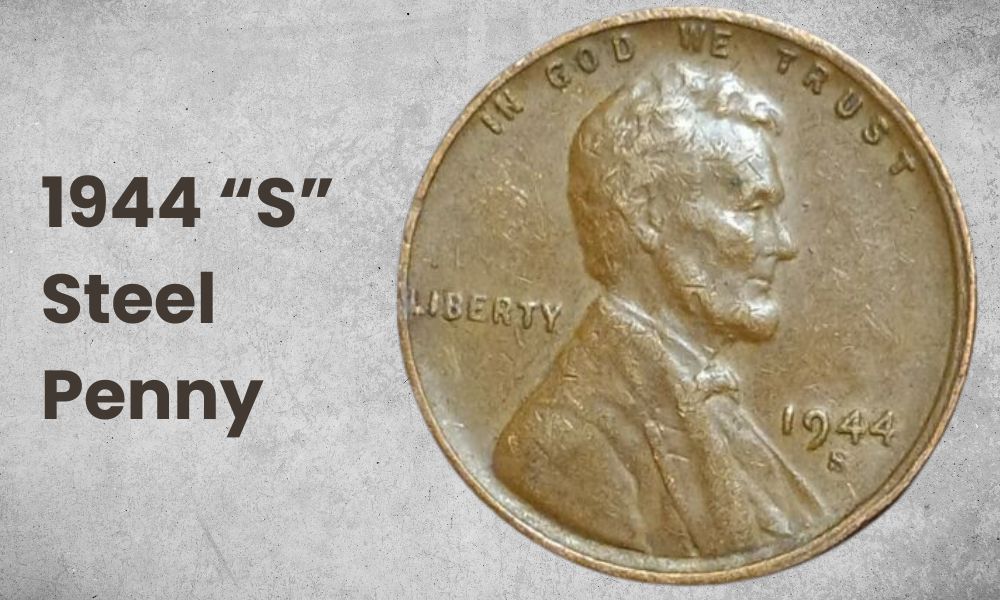
- Type: Lincoln Cents (Wheat Reverse)
- Mint Mark: S
- Minting place: San Francisco
- Year: 1944
- Edge: Plain
- Mintage: 2
- Designer: Victor D. Brenner
- Face value: $0.01
- Current value: $40,000 to $800,000
- Composition: Zinc-plated steel
- Mass: 2.7 g
- Diameter: 19 mm
Only two 1944 S steel pennies have been found so far. They are both regular-strike coins and have an “S” mint mark. They were created when leftover blanks from 1943 got into the 1944 bronze cents production stream.
Since they are even fewer than the Philadelphia and Denver steel pennies, they are rarer and more expensive than them. One can sell for $40,000 to $800,000.
1944 Steel Penny History
The 1944 steel pennies are part of the Lincoln Cent series. This series was launched in 1909 and has been minted every year since. Like the other Lincoln cents minted from 1909 to 1958, the 1944 steel pennies have wheat stalks in their reverse design.
As such, they are commonly referred to as wheat pennies. Keep in mind though; the 1944 steel penny also has other names because of its composition. These include steelie and steel war penny/cent.
Interestingly, the mint introduced this composition in 1943 to replace the original 95% copper and 5% tin & zinc. This was done because copper and tin were in short supply.
While the mint had planned to stick to this composition until 1946, they decided against it because they realized that these coins got corroded and stained easily.
But even after going back to the original composition of the Lincoln Cent, the mint wasn’t satisfied in the long run.
It still decided to change it again in 1982. Since this year, the mint has been producing copper-plated zinc coins. These have a composition of 97.5% zinc and 2.5% copper.
Design Changes from the 1944 Steel Penny Era
In 1959, the Lincoln cent’s reverse design changed to an image with the Lincoln memorial at its center. This was chosen to commemorate 150 years after Lincoln’s birth.
Also, the memorial had the words “E PLURIBUS UNUM” on top of it and legends around it, along the rim. These are “UNITED STATES OF AMERICA” at the top and “ONE CENT” at the bottom. The bottom one is in a larger font than the top one.
The mint ended up using this design until 2008. In 2009, it introduced new reverse designs to celebrate 200 years after the birth of Lincoln.
The four different designs depicted different phases of his life. One had a log cabin and depicted his birth and early years. Richard Masters designed this and Jim Licaretz sculpted it. It was the first to be released in February 2009.
The second design came out in May 2009 and depicts Lincoln’s formative years in Indiana. It features an image of him sitting down and reading. Charles Vickers both designed and sculpted it.
The third design came in August 2009 and depicts Lincoln’s professional life as a lawyer. Joel Iskowitz designed it and Don Everhart sculpted it. On the other hand, Susan Gamble designed the fourth coin and Joseph Menna sculpted it.
This coin features an image of the Capitol dome and represents Lincoln’s time as president. It came out in November 2009.
However, these designs didn’t stop the mint from introducing a new reverse design in 2010. This new design featured a union shield and is still used in coins minted today. This shield has an engraving of the words “E PLURIBUS UNUM” on its top part.
Beyond that, there’s a scroll across the shield bearing the words “ONE CENT”. Under this lies the initials “LB” representing the design’s creator; Lyndall Bass. Also, there’s a legend along the coin’s top rim that says, “UNITED STATES OF AMERICA”.
Keep in mind that the obverse design was also changed a bit in 2010.
1944 Steel Penny Grading
To accurately grade your 1944 steel penny, send it to a professional agency like PCGS or NGC. While this will cost you some money, it’s worth it because of the high value of these coins. If you don’t grade your coin, you can easily get ripped off.
List of 1944 Steel Penny Errors
Since 1944 steel pennies are scarce, it’s difficult to find any with errors. However, as more and more of them keep popping up, we may be able to identify some with errors in the future.
After all, 1944 steel pennies were themselves considered errors of 1944 bronze cents until recently. Even professional grading agencies like PCGS had included them in their mint error programs.
Keep in mind though; because of the high value of these coins, fraudsters have been known to create and try to sell fake versions. They are particularly known to plate ordinary 1944 bronze cents with zinc before selling them to unsuspecting collectors.
So before you buy any such coin, check it using a magnet; only buy it if it’s attracted to the magnet. There isn’t any kind of legitimate error in these coins that can make them non-magnetic.
Other Rare Pennies
Interestingly, the 1944 steel penny is not the only rare penny that was minted accidentally during a composition transition. It has a sibling; the 1943 bronze cent. This coin was minted at a time when the mint was transitioning into steel cents.
It’s widely believed that it was made using blanks that were leftover from the 1942 cent mintage and that they accidentally got into the 1943 production stream. As such, there are only 15 known and some still consider them errors under the 1943 steel cent type.
Since they are only 15, they are the rarest Lincoln cents and sell for a premium price. One of these coins graded MS63 by PCGS even sold for over $1 million in August 2018. Of all these coins, the rarest variety is undoubtedly the 1943 D bronze cent. There is only one known.
It’s therefore important to keep an eye on fakes; fraudsters have started applying copper layers to ordinary 1943 steel pennies to pass them off as bronze pieces. To figure out if you have the real deal, use a magnet on the coin. If it gets attracted, it’s a fake.
Another thing you can do is weigh your coin. Steel coins usually weigh 2.7 grams while bronze/copper ones weigh 3.11 grams.
However, keep in mind that many people don’t know about the 1944 steel penny and the 1943 bronze penny. As such, they believe that the rarest penny is the 1909 S penny with the VDB. But while this coin is rare, it doesn’t hold a candle to its two counterparts.
Also, it’s important to note that mintage is not the only driver of rarity. Some coins were minted in higher quantities but most of them were lost over time.
1944 Steel Penny FAQ
Why is a 1944 steel penny worth so much?
The 1944 steel penny’s premium price is not only a result of its low mintage. It’s also because these coins deteriorate easily by staining, making it difficult to keep them in good condition for a long time.
That’s why MS64 and above samples are few and even more expensive
How much is the 1943 vs 1944 steel penny worth?
While 1944 steel pennies are consistently expensive, a 1943 one can sell for as low as 17 cents per piece. If you want to make thousands off of a 1943 steel penny, you need one that is graded around MS68 and/or has some serious errors.
